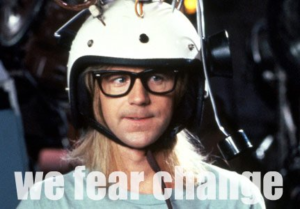The first thing that I noticed was my lack of anxiety.
Late on a summer Sunday afternoon, I emerged from the converted barn on a thirteen-acre ranch in the rolling hills of Northern California. I had just completed a four-day coaching training, and now it was time to head to the airport.
The ranch wasn’t an “Uber-friendly” location, so my assistant Kristen booked a car to Oakland so I could catch my flight home.
I grabbed my bags and looked around the gravel parking lot.
Hmm… no car.
If the car didn’t arrive in under five minutes, I would miss my flight.
When I’m late for a flight, I feel like there’s a conspiracy of forces arrayed against me.

- Traffic
- Errors on airline check-in websites (“Oops! There’s a problem and you’ll have to see an agent when you get to the airport.”)
- Slow-moving people in security lines (You’re just now realizing that you need to take your laptop out of your bag! Seriously?!)
Growing up, the message I got was that the universe was a hostile place. If you didn’t work to defend yourself, you’d be overwhelmed and overtaken. We are an island battered by a sea of cosmic forces.

So I learned to build a fortress and only let in things that I could control.
In the last few years, I’ve let the walls come down. I’ve worked to consciously flip the view that the universe is hostile.
It’s not my enemy, it’s my teacher.
So on that Sunday afternoon, instead of fighting the universe, I got curious:
Dear universe, what are you trying to teach me now?

Here’s what my clients see when they shift from control to curiosity:
Curious leaders solve their problems faster. When you let go of the belief that you need to know the answer, you unleash your creativity (and the creativity of those around you).
When you build allies and deepen relationships, you no longer have to push solutions out. Instead, you get to co-create them.
Curious leaders are less stressed and overwhelmed. When you shift from control to curiosity, your experience at work becomes… well, more fun. It’s still high-stakes — you’re still solving big, important problems. But setbacks become an expected part of the journey and you accept them as part of your experience.

Curious leaders become more influential and more visible in their organizations. You’ll get noticed and promoted.
One team that I’m working with is creating hundreds of millions of dollars of savings across their company just by asking better questions. Talk about getting noticed! Even better, their success lets them continue to shape their work in ways that are increasing their impact.
I’ve seen leaders from law to engineering, software, healthcare, and media cultivate their curiosity — and reap tremendous benefits. The industry and the challenges don’t matter.
For many of you, your default response is like mine: When you meet uncertainty, you come up with solutions and try to control outcomes. Even as you drown in emails and jump from back-to-back video calls, you get stuck in the fight to be right. As a result, you’re too busy but not impactful enough.
The truth is that we’re all doing the best with the tools we have.
Your reactions are smart! They have, after all, brought you successfully to this exact moment.
But control and striving don’t work anymore because things are getting worse.
Leadership is lonely — and the hybrid, post-pandemic world makes this worse. Leaders carry daunting burdens.
- How do you lead people in a function you’re not an expert in?
- How do you shape and shift the culture of your teams?
- How can you make progress on problems that are bigger than the areas you control?
And the pace of change is only getting faster.
So what can you do?

Start with curiosity. Curiosity helps us understand others. And nothing builds trust faster than seeing people for their strengths.
Curiosity also helps us bring awareness to our own reactions and lets us shift those.
As psychologist and Holocaust survivor Viktor E. Frankl wrote, “Between stimulus and response there is a space. In that space is our power to choose our response. In our response lies our growth and our freedom.”
How do we find that space? What would it be like to meet your challenges with openness and curiosity?
Remember my lack of anxiety in California?
When the car didn’t show up, I knew that I would miss my flight. My normal response would have been to be frantic and stressed out. Instead, I stepped into that space and it changed everything.
I surrendered to the moment. I laughed!
Then, I rescheduled my flight, caught a ride with one of my fellow coaches, and ended up spontaneously meeting with one of my best friends in the world that night.
You can step into this space, too.
How do I know? Because it’s a shift that I’m living (and one that I’ve guided hundreds of others through as well).
It starts with realizing that leadership (and life!) is not about certainty.
It’s about curiosity.
In 2022, I started an experiment. Could I guide a group of leaders — all from different organizations — on the same kind of journey that I offer in my consulting and one-on-one coaching?
The experiment was a resounding success. We brought leaders from a diverse set of industries together (over Zoom, natch!) once a month to learn together and support each other in tackling their thorniest challenges.
Over our year together, we explored each leader’s strengths and challenges (“When are you at your best? How do our strengths, overused, become liabilities?”)
We introduced knowledge and frameworks around curious questions, trust, and working with resistance.
We practiced and learned together.
Last year, I only opened this work up to a small group of clients. This year, I’m committed to offering this program to my whole community.

Change isn’t easy. The work is yours to do.
But if you’re interested, you will find everything you need to fundamentally change the way you lead in this program:
- Skilled guides.
- Deep and practical knowledge on how to build trust, get the best from people, and influence others.
- A safe and confidential space to practice with a community of fellow leaders.
Join me and learn to lead without stress and overwhelm. Let go of the way things “should” be and get curious about how they actually are. Learn how to build trust and create deeper relationships with a group of peers.
We’ll share more about the structure of the program on December 8th, but it includes:
- Nine hour-long group coaching sessions in 2023.
- Practical and rigorous leadership frameworks.
- Short videos and readings between sessions.
- Learning pairs to provide ongoing support.
- Intake and wrap sessions
The first step is to sign up for my free Lead Curious Open House.
At the Open House, we’ll give you a taste of what this work is like so you can decide if you want to join Lead Curious in 2023.
In just sixty minutes, you’ll get a chance to discuss a live work challenge with a peer and learn something about yourself.
Join us on December 8th from 9:00 am – 10:00 am Pacific (12:00 pm – 1:00 pm Eastern). My colleague Renya Larson and I will be running an interactive workshop with Q&A to follow.
P.S. I’m only planning on launching this program once per year, so if you’re interested, don’t miss this! Reserve your free spot today!



